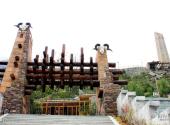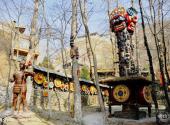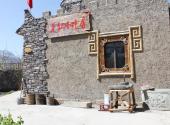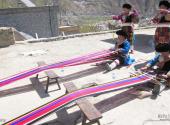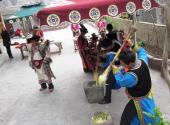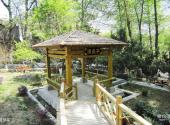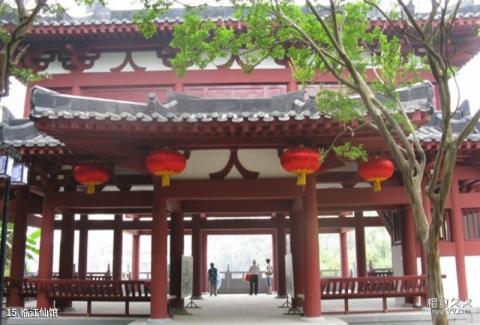
Scenic spot introduction:
The ancient Qiang Village in Maoxian County is a perfect combination of the famous "Fruit Village" and the beautiful "Shui Feng Qiang Village", and is the only living museum of Qiang culture in the world. Walking in the Qiang Village, you will see the clear small bridges and streams, the leisure wicker chairs and tea seats, the warm courtyard houses, as well as the exquisite bonsai and gorgeous flowers in the courtyard. If it were not for the obvious totems on the walls of the houses, visitors would seem to have come to a tender place. Lijiang, all the leisure can not help but give people frequent illusions. The love songs engraved on the stones on the roadside, the huge wine jars with the aroma of wine wafting out, the Nuo masks with different expressions and the Nuo cultural symbols that can be seen everywhere, the ancient villages and Qiang buildings all combine the long history of the city. Intangible cultural heritage such as Tusi official village culture, original Qiang folk culture, Qiang food culture, Qiang embroidery art and culture are presented to every tourist without reservation, making people linger intoxicated.Attractions distribution:
Qiang Township Ancient Village is located in Nanxin Town and Fengyi Town in Mao County, Aba Prefecture. It consists of Moutuo Qiang Village and Pingtou Qiang Village. Moutuo Village is 1,400 meters above sea level. It retains the "5.12" earthquake ruins, earthquake stones and ancient caravan roads. It has Xingfu Avenue, Thanksgiving Pavilion, Memory Square, Hanshui Fish Farm, Salang Old Street, Qingquan Pavilion, agricultural sightseeing park, etc. It is known as the "Peach Garden of Qiang Township". Pingtou Village is 1,688 meters above sea level. It has the traditional old houses of the Qiang people, a wine-sipping square, a tourist hotel converted from residential houses, and the Shibi Cultural Corridor. It is a living Qiang cultural museum. In the two Qiang villages, tourists can see the manifestations of ethnic characteristics such as drinking wine, Nuo culture, and Qiang watchtowers. They can also buy embroidery and other ethnic handicrafts, and taste delicious Qiang dishes.Scenic spot qualifications:
Ecological demonstration village and rural tourism demonstration village.Scenic spot features:
Leisure, ethnic customs, ancient villagesScenic spot map:
travelling guideline:
Special festivals:
1. Qiang New Year: the first day of the tenth lunar month. Singing drinking songs, drinking homemade wine, "dancing sirloin", "dancing armor", "leather drumming", etc. are the most important festivals of the Qiang people.
2. Mountain Festival: March to June of the lunar calendar, the most common is April 12 of the lunar calendar. Men and unmarried women dress up in costumes, bring all kinds of exquisite festive feasts, wine and food, and bring cattle, sheep, chickens and other live animals up the mountain. After the blessings are completed, cows, sheep, and chickens are sacrificed to the gods of heaven, mountains, and woods, and cypress branches are burned. Then auspicious words are chanted, and the wishes are recited collectively, and then the wishes are made to each individual. This ceremony takes several hours or even a day, and everyone No one can bow and worship, only the Shibi or the presiding officer can move. Finally, after swearing an oath of village rules and ancestral traditions, they collectively shouted, fired guns, cheered, and feasted, sang, and danced until they returned home happily. The remaining food is distributed equally among all.
3. "Waer's Foot" (Leading Song Festival): the fifth day of the fifth lunar month. The women brought sacrifices and food to the seaside near the village, offered offerings to Sharon and prayed for protection. Then, they formed a circle, held hands and danced the sirloin dance.
4. Ox King Meeting: November 1st of the lunar calendar. On this day, the cattle rest and are fed with flour, steamed buns and wheat straw. Make a sun and moon-shaped bun and hang it on the horn of the cow, and then let it out of the circle to move around freely. The owner went to the Niu King Temple to burn incense and paper, and slaughtered a sheep and a chicken to pray to the Niu King to protect the cattle from the plague.
Tour route:
Moutuo Qiang Village: Village Gate → Qiang Style Street → Visitor Center → Xingfu Avenue → Ancient Walnut Tree → Earthquake Stone → Impression Stone → Zhongzhai Road → Sheep Head Totem → Octagonal Qiang Sculpture → Salang Old Street → Wine Sipping Terrace → Sa Lang Square → Memory Square → Plank Road → Thanksgiving Pavilion → Thanksgiving Stone (the whole journey takes about 70 minutes).
Pingtou Qiang Village: Visitor Reception Center → Biangou Alley → Ziya Pavilion → Qiang Xiuzhuang → Country Road (Liu Hongli’s House) → Xiaoshuigou → Beishui Alley → Music Corridor (from Yu Chongen to the entrance of the middle alley Office) → Liquor Square → Nuo Cultural Square → Shibi Cultural Corridor → Xueping Road (the whole journey takes about 50 minutes).
Best time to visit:
From April to November, ethnic festivals are more concentrated.
Shopping recommendations:
(Shopping) Qiang embroidery, Qiang flute, horn products, Qiang costumes, Wenmao apples and other special fruits, Cordyceps and other special Chinese herbal medicines.
(Gourmet food) Steamed noodles, wrapped in gold and silver, gnocchi, sliced noodles, steamed buns, baked steamed buns, dough balls, rolled noodles, bed-rolled noodles, boiled potatoes (potatoes), potato glutinous rice cakes, sauerkraut, bacon Vegetables, bacon, etc.
Scenic spot map:
Scenic spot location:
China>Sichuan Province>Aba Tibetan and Qiang Autonomous Prefecture>Mao County
How to get there:
Bus route: Take long-distance buses from various places to Maoxian Passenger Transport Station, then transfer to the shuttle bus to Nanxin Town, Moutuo Village, Pingtou Village or take a taxi.
Self-driving route: Take Chengdu-Guan Expressway in the direction of Chengdu → Duwen Expressway, drive towards Wenchuan, turn into G213 at Sangping Bridge, drive to Moutuo Village and then reach Moutuo Qiang Village; continue driving towards Maoxian County. You can go to Pingtou Qiang Village.
Scenic area map:
Click to expand the scenic area map
Ticket prices for Qiangxiang Ancient Village:
Qiang Township Ancient Village: Free admission
Pingtou Qiang Village performance fee: 100 yuan/person
Baishi Qiang Village performance fee: 80 yuan/person
Moutuo Qiang Village Performance fee: 100 yuan/person
Zipline: 40 yuan/person
Sightseeing bus: 15 yuan/person
Scenic area opening hours:
All day

